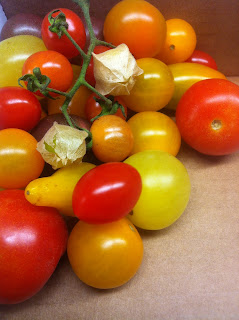Q. Mark H asks, "Why do we sell the Green Beans with the fruit?" (& Burdock, Radicchio, Endive, etc.)
A. The 28 foot "fruit" display is set at 2 different temperatures, the first 16 feet at about 46º and the last 12 about 38º. Green Beans, Cucumbers, Basil, etc., must never get too cold (they will rot) and the entire 56 foot run of "vegetables" is set at about 38º. Some of the vegetables at the other end of the "fruit" run from Green Beans need to be dry and cold, and could be stocked near the Mushrooms, but we just don't have enough room.
Q. "I get it", says Mark, "but why is the Basil sold from that box?"
A.
It is very difficult to store and display Basil. Its ideal temperature
is between 50 and 55; it won't withstand temperatures below 48. It also
doesn't like to get wet or blown upon. We built the "house of Basil" to
protect it. At home, wrap Basil and protect from too much chill, using
the drawer or door of refrigerator. If Basil has roots, try keeping it
unrefrigerated, with just the roots covered in water. Best bet? Eat it
or make pesto right away.
Q. Lisa M asks, "Carrots are orange. Where did all of those other colors come from?"
 A. Orange Carrots seem normal to us, but they are a
relatively new development. Purple, red and yellow Carrots have been
known for over a thousand years possibly originating in the Afghanistan
region. The orange Carrot did not appear until the 16th century in the
Netherlands. Many believe that the Dutch developed the orange Carrot to
honor King William I, William of Orange, but there is no evidence to
support this. So all you traditionalists, you hybrid avoiders, this
gives you something to think about!
A. Orange Carrots seem normal to us, but they are a
relatively new development. Purple, red and yellow Carrots have been
known for over a thousand years possibly originating in the Afghanistan
region. The orange Carrot did not appear until the 16th century in the
Netherlands. Many believe that the Dutch developed the orange Carrot to
honor King William I, William of Orange, but there is no evidence to
support this. So all you traditionalists, you hybrid avoiders, this
gives you something to think about!This is a great week for eating rainbows. We have Rainbow Bunch Carrots, Rainbow Chard, Rainbow Cherry Tomatoes, Rainbow Fingerlings. Even the Turnips are a blend of gold, scarlet, white and purple top. Many members choose to eat rainbows because the colors are produced by various phytochemicals that naturally occur in fruits and vegetables. Some of the more familiar ones are anthocyanins, the blue in Blueberries. Lycopene causes the red in Tomatoes, carotene the orange in (orange) Carrots, pycnogenols the reds and purples in Grape skins. Many members appreciate the antioxidant qualities, among other health benefits that these phytochemicals provide. I'm happy to eat phytochemicals, and fiber, vitamins, and minerals, but that's not why I like to eat rainbows.
We eat (and shop) with our eyes. We cook with our noses. We serve and we share with our hearts. Eating rainbows makes us happy. That's good enough for me.
Allen Zimmerman - Produce Buyer - General Coordinator


